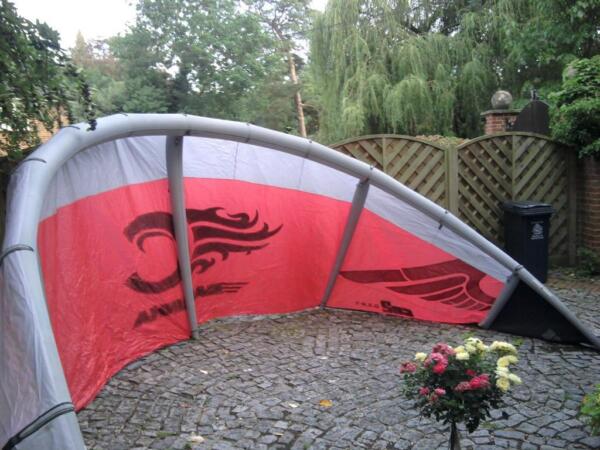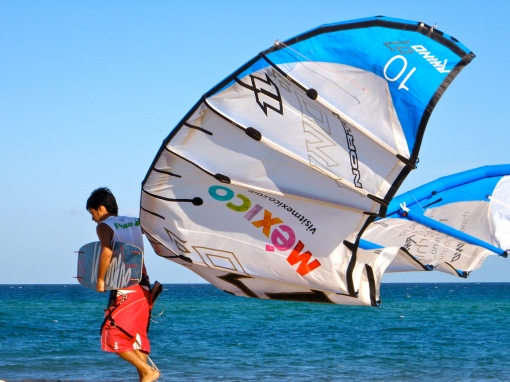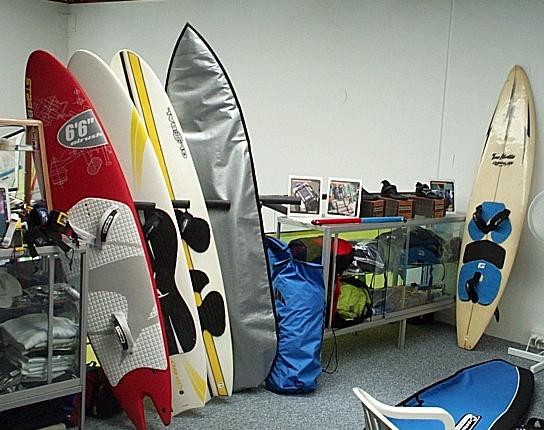Source(google.com.pk)
KiteSurfing Gear Biography
How to choose your Kitesurfing gear
Deciding to take up kitesurfing can feel like a pretty big step. Unlike other sports (tennis say), you have to invest quite a few bucks (more than the cost of a racket!) to ensure that you can get out on the water whenever it's on, and to have kit that performs well and will ensure that your riding progresses.
On the plus side, modern kit is built to last and - as we'll look at later - if you make the right choices then your kit won't be outdated for a few years. Realistically you can expect to get around three years of good use out of a kite before it's time to hit up the plastic again. (Although if you've really got the bug then 'next year's kit' might be too tempting to resist!)
Before you get started though, it's important to remember that unlike other sports (such as surfing or windsurfing), you can't really 'ease yourself into' kitesurfing - you can't simply drop the sail, or ditch the board, and then just have another go - kites are incredibly powerful bits of kit and if you don't know what you're doing then you can easily find yourself wrapped around a groyne or stuck up a tree... Modern kites are very safe, but only once you know what you're doing, and you should never just buy a kite, go to beach, and 'give it a go'! The best advice - even if you're an experienced surfer or can land loops on your windsurfer at will - is to take a couple of lessons and get to grips with the controls and, most importantly, what to do if everything starts going wrong - at the very least make sure you're learning with a mate who knows their stuff.
So, assuming you know your pump from your pigtails, it's time to get to the shop and invest in your kitesurfing future!
So, what do I need?
It you've had lessons at a kiteschool then you'll probably have used their beginner specific kit. This is great for getting you up and riding and for teaching you the basics of wind awareness and kite skills, but in reality if you buy this as your first set up then you'll have outgrown it in a few weeks. The trick to buying your first set up is to choose kites and a board that will take you comfortably from beginner through to intermediate.
Kites Most modern kites have excellent depower - which is what you want when you're starting out. Being able to ditch the power is great for confidence when you're at the start of kitesurfing's steep learning curve. So steer clear of C kites (like the Naish Torch or the Hadlow Pro) as, although these have much more depower than a few years ago, they are freestyle power machines, and a lot less forgiving than Bow (full depower) and Hybrid (high depower) kites. (For more detail about types of kite check out this article)
Great options that will take you comfortably from beginner through to intermediate (and beyond) include the Cabrinha Crossbow, which offers heaps of depower and is one of the longest serving and most refined kites on the market, and the Best Kahoona which offers superb depower as well as plenty of hangtime when you start popping those first airs!
Can I get by with 1 kite? Modern kites do have excellent wind range, but don't believe the manufacturers' hype about a kite being usable in anything from 9 - 39 knots! This may be possible, but it won't be much fun at either end of that range and, in reality, you do need a minimum of a 2 kite quiver. Popular options are a 7M, 10/11M quiver, or a 9M, 12M combo depending on your local conditions and your weight (with heavier riders needing gruntier sized kites).
The right quiver should get you out most days at your local beach. (Although it probably won't be long until you invest in a 4 or 5M kite for when it's seriously on!)
And remember (especially if you're buying second hand) that bars belong with kites. Never mix and match bars with different kites - safety systems and bar set ups are always kite specific so mismatched kit could be lethal... You can, of course, use different size kites with the same bar though, so look at picking up two of the same model kite and one bar if you can.
Board If you didn't know when you began your kitesurfing career, then after a few lessons you'll probably have a good idea of the direction that you want your kiting to go in: freestyle, wave, or racing for example. Wherever you want to end up though, you'll generally be best off spending your first few session on a twin-tip (freestyle board). These are easy to manoeuvre, fairly easy to 'get up' on and, best of all, you can ride them both ways without turning the board round! If you're planning on moving onto a surf or a race board then put some calls in to your mates and see if anyone's got a battered old twin tip in the shed that you can borrow for a few weeks. If you're planning on sticking with freestyle then most twin-tips on the market will take you from beginner through to intermediate/advanced. The only tip would be: don't go too small, or too big. Something like the Naish Haze or Best's Spark will take you comfortably through beginner and into your intermediate days...
If you are hoping to get straight into surf or racing then - once you've mastered the basics with a few twin-tip sessions - choose whichever board suits you. There is no real distinction between 'beginner' and 'advanced' surf or race boards (mainly as they've got much more 'float' than twin-tips) - you just need to find the right board for your height and weight and, if surfing, for the kind of waves that you will be taking on.
Harness Pretty important! There are two types of harness: seat and waist. If you've had a few lessons then odds-on you will have used a seat harness. These offer great support and stay in place even when you're getting dragged around in the shallows. A waist harness, on the other hand, offers more movement when you've mastered the basics, but can get pulled into uncomfortable positions when you're starting out! It's a difficult call really - your best bet is to head down to your local store and try a few on. If you can find a waist harness that feels pretty solid then it may be worth sucking up those sore ribs for a few weeks to save having to change up in a few months time when you've outgrown your seat harness. Mystic have a great range, and their Dragon Shield is a good entry level option.
There's no doubt that 2011 is a great time to be getting into kitesurfing - the kit really is the best it's ever been - with high-tech R&D and top build quality the norm. So: do your research, check out your options, and then get yourself kitted out for an exciting first few years of kiting.






















KiteSurfing Gear Biography
How to choose your Kitesurfing gear
Deciding to take up kitesurfing can feel like a pretty big step. Unlike other sports (tennis say), you have to invest quite a few bucks (more than the cost of a racket!) to ensure that you can get out on the water whenever it's on, and to have kit that performs well and will ensure that your riding progresses.
On the plus side, modern kit is built to last and - as we'll look at later - if you make the right choices then your kit won't be outdated for a few years. Realistically you can expect to get around three years of good use out of a kite before it's time to hit up the plastic again. (Although if you've really got the bug then 'next year's kit' might be too tempting to resist!)
Before you get started though, it's important to remember that unlike other sports (such as surfing or windsurfing), you can't really 'ease yourself into' kitesurfing - you can't simply drop the sail, or ditch the board, and then just have another go - kites are incredibly powerful bits of kit and if you don't know what you're doing then you can easily find yourself wrapped around a groyne or stuck up a tree... Modern kites are very safe, but only once you know what you're doing, and you should never just buy a kite, go to beach, and 'give it a go'! The best advice - even if you're an experienced surfer or can land loops on your windsurfer at will - is to take a couple of lessons and get to grips with the controls and, most importantly, what to do if everything starts going wrong - at the very least make sure you're learning with a mate who knows their stuff.
So, assuming you know your pump from your pigtails, it's time to get to the shop and invest in your kitesurfing future!
So, what do I need?
It you've had lessons at a kiteschool then you'll probably have used their beginner specific kit. This is great for getting you up and riding and for teaching you the basics of wind awareness and kite skills, but in reality if you buy this as your first set up then you'll have outgrown it in a few weeks. The trick to buying your first set up is to choose kites and a board that will take you comfortably from beginner through to intermediate.
Kites Most modern kites have excellent depower - which is what you want when you're starting out. Being able to ditch the power is great for confidence when you're at the start of kitesurfing's steep learning curve. So steer clear of C kites (like the Naish Torch or the Hadlow Pro) as, although these have much more depower than a few years ago, they are freestyle power machines, and a lot less forgiving than Bow (full depower) and Hybrid (high depower) kites. (For more detail about types of kite check out this article)
Great options that will take you comfortably from beginner through to intermediate (and beyond) include the Cabrinha Crossbow, which offers heaps of depower and is one of the longest serving and most refined kites on the market, and the Best Kahoona which offers superb depower as well as plenty of hangtime when you start popping those first airs!
Can I get by with 1 kite? Modern kites do have excellent wind range, but don't believe the manufacturers' hype about a kite being usable in anything from 9 - 39 knots! This may be possible, but it won't be much fun at either end of that range and, in reality, you do need a minimum of a 2 kite quiver. Popular options are a 7M, 10/11M quiver, or a 9M, 12M combo depending on your local conditions and your weight (with heavier riders needing gruntier sized kites).
The right quiver should get you out most days at your local beach. (Although it probably won't be long until you invest in a 4 or 5M kite for when it's seriously on!)
And remember (especially if you're buying second hand) that bars belong with kites. Never mix and match bars with different kites - safety systems and bar set ups are always kite specific so mismatched kit could be lethal... You can, of course, use different size kites with the same bar though, so look at picking up two of the same model kite and one bar if you can.
Board If you didn't know when you began your kitesurfing career, then after a few lessons you'll probably have a good idea of the direction that you want your kiting to go in: freestyle, wave, or racing for example. Wherever you want to end up though, you'll generally be best off spending your first few session on a twin-tip (freestyle board). These are easy to manoeuvre, fairly easy to 'get up' on and, best of all, you can ride them both ways without turning the board round! If you're planning on moving onto a surf or a race board then put some calls in to your mates and see if anyone's got a battered old twin tip in the shed that you can borrow for a few weeks. If you're planning on sticking with freestyle then most twin-tips on the market will take you from beginner through to intermediate/advanced. The only tip would be: don't go too small, or too big. Something like the Naish Haze or Best's Spark will take you comfortably through beginner and into your intermediate days...
If you are hoping to get straight into surf or racing then - once you've mastered the basics with a few twin-tip sessions - choose whichever board suits you. There is no real distinction between 'beginner' and 'advanced' surf or race boards (mainly as they've got much more 'float' than twin-tips) - you just need to find the right board for your height and weight and, if surfing, for the kind of waves that you will be taking on.
Harness Pretty important! There are two types of harness: seat and waist. If you've had a few lessons then odds-on you will have used a seat harness. These offer great support and stay in place even when you're getting dragged around in the shallows. A waist harness, on the other hand, offers more movement when you've mastered the basics, but can get pulled into uncomfortable positions when you're starting out! It's a difficult call really - your best bet is to head down to your local store and try a few on. If you can find a waist harness that feels pretty solid then it may be worth sucking up those sore ribs for a few weeks to save having to change up in a few months time when you've outgrown your seat harness. Mystic have a great range, and their Dragon Shield is a good entry level option.
There's no doubt that 2011 is a great time to be getting into kitesurfing - the kit really is the best it's ever been - with high-tech R&D and top build quality the norm. So: do your research, check out your options, and then get yourself kitted out for an exciting first few years of kiting.
KiteSurfing Gear
KiteSurfing Gear

KiteSurfing Gear

KiteSurfing Gear

KiteSurfing Gear

KiteSurfing Gear

KiteSurfing Gear

KiteSurfing Gear

KiteSurfing Gear

KiteSurfing Gear

KiteSurfing Gear

KiteSurfing Gear

KiteSurfing Gear

KiteSurfing Gear

KiteSurfing Gear

KiteSurfing Gear

KiteSurfing Gear

KiteSurfing Gear

KiteSurfing Gear

KiteSurfing Gear

KiteSurfing Gear

KiteSurfing Gear

KiteSurfing Gear
Hi, I want to know about price of these all Kitesurfing Gears. Waiting for your reply.
ReplyDeleteI am happy that I found your post while searching for informative posts. It is really informative and quality of the content is extraordinary.
ReplyDeleteNeed any managed services visit us